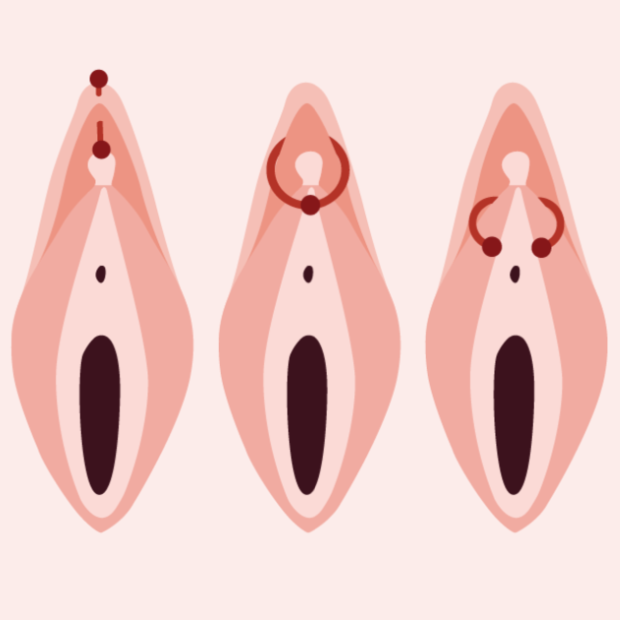Your Guide To Clit Piercing (With Photos Of The 4 Best Options)
There are a few things to know before you go.
 Marie-Michèle Bouchard / Unsplash
Marie-Michèle Bouchard / Unsplash So, you've decided to pierce your vagina. Your clitoris, to be more precise.
Before you step into just any piercing place, there are some important things for you to consider when getting a clit piercing, or any genital piercing, really. Never get your genitals pierced by just anyone; always find a reputable vagina piercing artist. If you don't know where to start, ask your friends. Sites like Yelp can also be a great resource.
However you hunt for your piercing soulmate, make sure you do your homework. You want an experienced professional who is certified and clean as a whistle. Sure, you could walk into a piercing parlor and just ask for a genital piercing. But be warned, there are several types and they all have different benefits.
What is a clit piercing?
A clit piercing is a piercing that's attached to the body's external part of the clitoris, the clitoral glands, which is the small nub at the top of the vulva.
The piercing can also be attached to the clitoral hood, which is a part of the skin that covers and protects the external clitoris. This piercing is the most common and safest.
However, there are four basic kinds of genital piercings for women, and not all of them involve the clitoris, although the most popular do. Some include piercing the labia majora of labia minora.
It's worth noting that you can combine these four if you want several piercings at once on your labia and clitoris.
RELATED: Every Question You've Ever Had About Genital Piercings, Answered
What are the different types of clit piercings?
1. Vertical or horizontal clitoral hood piercing
The clitoral hood piercing looks like a piercing that rests on top of the clitoris. It's pierced either vertically or horizontally through a thin section of the hood’s peak.
The jewelry used for this piercing is typically a curved barbell for a vertical clitoral hood (VCH) piercing, and a captive bead ring for a horizontal clitoral hood (HCH) piercing.
How bad does a hood piercing hurt? Like any piercing, the pain will depend on your individual pain threshold. Clitoral hood piercings are in a sensitive place, so you might feel more pain than any other piercing. However, the procedure is quick.
2. Triangle piercing
Less than half of women are suited for the triangle piercing because all vulvas are different, and this one needs to go horizontally through the base of the clitoral hood and underneath the shaft of the clitoris.
The triangle piercing rests below the clitoral shaft. For those able to get it, some report enhanced sexual pleasure because the jewelry stimulates the clitoral shaft from behind, and presses sweet spots that you can't reach otherwise.
The jewelry used for this piercing is a circular barbell; however, some do prefer rings.
Pictured below, from left to right: vertical clitoral hood piercing, horizontal clitoral hood piercing, triangle piercing
 Photo: Alex B Porter / Wikimedia Commons
Photo: Alex B Porter / Wikimedia Commons
3. Clitoral glans piercing
The clitoral glans piercing is the only piercing of this type that actually pierces the clitoris, going straight through the glans; if it's a vertical piercing, it goes through the clitoral head, and if it's a horizontal piercing, it goes through the midpoint.
However, because of the piercing's location, it's the least common among women. Most clitorises are heavily hooded and/or too small to receive the piercing; the glans also contains a concentrated amount of nerve endings.
4. Christina piercing
You'll be able to see a Christina piercing right away because it's located at the top of the vulva. The piercing rests on the mons pubis, which is at the top of the vulva and looks like a very long piercing.
The Christina piercing is mostly for beauty purposes and doesn't help or enhance sexual pleasure. The jewelry used for this piercing includes surface bars or curved barbells, both of which tend to be soft and flexible materials.
5. Princess Diana piercing
A Princess Diana piercing is located on the outer sides of the clitoral hood. If a woman's hood is big enough, the vertical piercing can be combined with a Princess Diana on both sides.
It may seem strange that a clitoris piercing is named after an actual princess. So, why is it called a Princess Diana piercing? The piercing was created by piercer Elayne Angel who started the trend.
"The piercing is named after the first woman I performed them on, and Princess Diana had been in the news at the time, so we added 'Princess' to give female royalty some exposure in the piercing world," Angel says. "It was about time, since the Prince Albert (the most popular male genital piercing) has had so much of it."
The jewelry is the same as a vertical piercing (VCH), using either a curved barbell or a captive ring.
What jewelry material should I choose?
For clitoris piercings, always use jewelry recommended by the Association of Professional Piercers (APP). They recommend solid 14-karat gold or higher, as well as implant-grade metals approved by the ASTM International or International Organization for Standardization (ISO).
For clitoris piercings, get either stainless steel piercings that are ASTM-F138 or ISO-5832-1 compliant, titanium piercings that are ASTM-F136 or ISO 5832-3 compliant, or solid 14-karat gold or higher.
Stainless steel piercings are the most affordable and safe for most, even those who have a nickel allergy. The titanium is more expensive but it's hypoallergenic and nickel-free. Lastly, the solid 14-karat gold piercings are the most expensive, but there are perks like choosing colors from yellow, white, or rose gold.
How much does a clit piercing cost?
Typically, a clit piercing can range from $50-$100, but that's just for the service. However, the price can increase depending on the studio and the location. The jewelry is then an additional cost, ranging from $20-$60, depending on the material you choose.
There also might be a consultation fee if you go to a reputable piercer for an evaluation before your genital piercing to check your suitability. But some apply that fee to the piercing total.
After the piercing costs themselves, it's essential to give a tip to your piercer, which is normally an extra 20 percent of your total.
What are the risks of getting a clit piercing?
There can be many risks when getting a genital piercing. It's a very sensitive area and if you're not careful, things could go wrong or your body could react negatively.
Here are a few risks to know about before getting a clit piercing.
1. Allergic reaction
Some people might not know it, but if you're allergic to nickel and get a stainless steel piercing with nickel in it, you could be putting yourself at risk for an allergic reaction.
That's why it's worth it to upgrade to either titanium or solid 14-karat gold if you think you might be allergic.
2. Tearing
This can be a painful risk because the skin down there is very delicate. Tearing can easily happen from washing your body in the shower, going to the bathroom, or having sex.
3. Infection
If you or your piercer don't follow proper piercing hygiene, you could end up with an infection. This can also happen if you don't go to a high-quality piercing shop, as there might be unclean needles or unsanitary conditions.
4. Embedding
If your piercing is too short or too thin, your skin will grow over the piercing and embed it. Embedding happens when your body tries to absorb the piercing, and can cause serious issues.
5. Migration and rejection
Piercings can often move and shift during healing, and this can happen if there's not enough tissue to hold the piercing. Your body could also reject the piercing by migrating to the surface of your skin and falling out.
6. Nerve damage
Piercing your clitoral area comes with a high risk of possibly damaging your clitoral nerves and not being able to feel pleasure. This is the highest risk for those who get a piercing through the actual clitoral gland.
7. Botched piercing
Once again, always go to a professional. You never want to risk getting a botched piercing where the piercer pierced the wrong area, or doesn't have enough expertise to give such a sensitive piercing.
How long does it take for a clit piercing to heal?
Take the healing process seriously. Try not to shave, groom, masturbate or have sex, including oral sex, while you're healing and in recovery. Always follow the instructions provided by your piercer so you don't end up with pain, infection, or complications.
For each clit piercing, the healing time can vary. For some women, it may take as little as 4 weeks or as long as 24 weeks to heal. The average time takes between 4-8 weeks.
What are the benefits of clit piercings?
If you don't know what kind of piercing you want, ask yourself what you hope to gain from the jewelry. Most women get clit piercings or genital piercings because they increase sexual pleasure and sensations; others get it for beauty purposes.
Do clit piercings increase sensitivity? Some clit piercings do increase sensitivity and sexual pleasure, including the vertical clitoral hood piercing, Princess Diana piercing, and triangle piercing.
Interestingly, inner labia and hood piercings are recommended as easier for first-timers in terms of both pain and healing time. And fun fact: You don't need to worry about shaving your pubic hair beforehand; the hair won't hinder the piercing or healing process.
How do you clean and care for a clit piercing?
1. Be careful when cleaning the area.
Clean the genital piercing in the shower and never in the bath tub' that could introduce bacteria, causing irritation or infection. Also refrain from using any harsh soaps. Wash your piercing daily with a sterile saline solution, even after sex.
2. Avoid bodily fluids coming into contact with the area.
Don't allow any bodily fluids to come into contact with the new piercing for the first few weeks of healing. This includes semen and saliva. Use a condom if you're having sex, masturbating or using sex toys.
3. Practice good hygiene.
Always wash your hands before touching your piercing, but keep in mind that touching should be avoided as much as possible. Urinate after you've cleaned your piercing, shower daily, wear clean clothing and soft underwear, and sleep on clean bedding.
4. Be aware of any complications.
You can successfully remove and change the piercing once it's fully healed, but you should first talk to your piercer and ask for professional approval.
If you experience any skin that’s inflamed and hot, pain when you clean, pelvic pain when you move around, pus leaking from the piercing, foul odor, or any flu-like symptoms, go to your piercer or a medical professional immediately to get the piercing removed.
Rebecca Jane Stokes is a writer and the Senior Editor of Pop Culture at Newsweek with a passion for lifestyle, geek news, and true crime.
